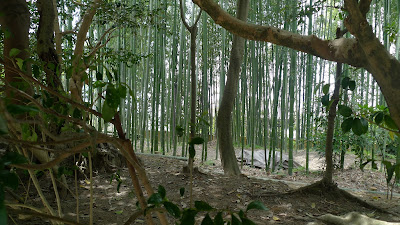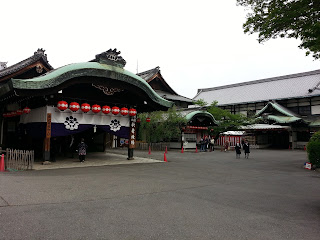MONDAY
The Golden Pavillon
After breakfast at the hotel, we met a different guide today as we were going for a day trip to Kyoto. Instead of taking the train, the company has provided a coach for us today and soon we were on our way. Kyoto is approx. an hour more from Osaka and of course, we always took the opportunity to cat-nap in the coach.
Our first destination of the day... Kinkaku, the Golden Pavillon
the entrance tickets for both the Gold and Silver Pavillons... like the chinese "fu"!
We were informed by the guide that today (25th April) is the beginning of the Japan's golden week holidays. Hence there were large groups of school children as well as Chinese tourists (us including hahaha).
In Japanese traditional gardens, the pond represents the sea and usually there are several islands because a sea without island is not acceptable in Japanese philosophy. Some of these "islands" are inaccessible as they represent the mythical places inhabited by immortals.
gold peeking through.....
yes, you can only view the pavilon from this area....
Notice the different architect style of the 3-storeys: the ground floor built with natural wood pillars as used for imperial building during the Heian Period; the 2nd floor resembled a samurai residence with its exterior covered in gold leaf while the top level is built as a Chinese Zen hall, again covered in gold and a golden phoenix is placed on top of the roof. This area belongs to Yoshimitsu, a shogun who willed it to be a temple after his death. This present structure was rebuilt in 1955.
The Carp rock ......
Tossing coins, a common practice of worship in Japan...
Beautiful greenery
The present day teahouse in the temple grounds and the tsukubai, the small stone water basin with water flowing through the bamboo pipe. This is used by visitors for cleansing hand and mouth ritual.
The Sekkatei (Place of Evening Beauty) Tea house built by the Shogun Yoshimitsu and this site was chosen as it was ideal for to watch the sunset.
an explanation of the roof structure of the Pavillon!
Japanese Zen garden were invented more than 700 years ago and the art is still being perfected till now
Beautiful sculptured bonsai trees
This is a 600 years old pine tree at the Shogun's villa ...
shaped like a sailing ship....if can you can visualise it....
Japanese rock garden are known as karesansui meaning dry landscape. These gardens are usually made for meditation purpose and can be seen inside temples.
Most Japanese gardens used both sand/gravel which represent water or the sea; and rocks which symbolise islands.
But in this garden, only sand is used and the parallel lines of the sand are raked by the master to represent a calm sea... "the Sea of Silver Sand".
This cone of sand is 2 meters tall is known as kogetsudai meaning "moon viewing platform" because when when viewed from the top floor of the Silver Pavillon during the full moon, it look like the reflection of the moon on a quiet pond... of course there is no entry now so not sure whether story is true!
It is so relaxing to walk along these paths and views
the moss garden around the Silver Pavillon
here the pine trees are well supported, even though they must be old.
a splash of red amidst the greenery.... surely this place will look glorious in autumn.
The Silver Pavillon built by Shogun Yoshimasa, (the grandson of the Shogun of the Golden Pavillion) as his retirement home.
"Despite its name, the Silver Pavilion was never covered in silver. Instead, it is believed that the name arose as a nickname more than a century after the building's construction to contrast it with the Golden Pavilion. Alternatively, it is explained that moon light reflecting on the building's dark exterior (which used to be covered in black lacquer in the past) gave it a silvery appearance."(Kyoto Travel)
another tired one..... they climbed up the path which lead uphill where you can see the view of the temple and its surroundings.
sake with gold dust only from Ginkakuji Kyoto special souvenir.
There were many stalls selling foods and souvenirs on the way out.
Towards Ninen-zaka shopping area ...
the signboard for Tetsugaku no Michi (Philosopher's Walk)
the shops maintaining the ancient Japanese architectural style.
lunchtime.... buckwheat Soba very popular around this area due to the fresh water supply from the mountains.
Now this is what I called a "heavy meal". This soba set together with unagi rice as well and we got to share the meal which the Japanese does not do ie sharing meals.
the red coloured gates to Kiyomizudera Temple...
another tsukubai .... for cleansing ritual before entering the temple..
ema- so many prayers and wishes....
meaning "Pure Water temple" is a UNESCO heritage listed in December 1994. . The temple building was constructed in 1633.
According to legend, a monk called Enchin was told to "look for the clear water origin of the Yodo river". And during his search, he met a hermit and was given a piece of wood which was possessed by the spirit of the Kannon (Bodhisattva of Mercy and Compassion). It was carved into likeness of the Kannon and later enshrined in the small hut and throughout the years it became the Kiyomizudera (The Clear water temple).
This is the popular Butai (dancing stage).
see how far down or shall I say how high this temple is above the ground level..
This is built of edge of a 13 meter steep slope
the panoramic view around the butai
Looking down from the main temple we can see the people queuing up to sip from the Otowa-no waterfall for longevity, health and success in studies.
the well-worn smooth pattern of the wooden platform...
AWESOME
The huge pillars are tied horizontally and so perfectly assembled and not a single metallic nail was used hence there are no gaps created by dilatation or contraction.

WONDERFUL
The temple is able to withstand earthquake resistant and can support the large weight of the floor.
In Kyoto we can see many young ladies in the traditional kimono. .. not sure whether they are Japanese or tourists because you can actually rent a kimono which include makeup and hairdo as well.
Kyo ware- pottery made at Kiyomizu in the past. Kyoto was the center of culture 400 years ago and when tea ceremony became popular, teacups and other potteries were produced.
Notice these traditional wooden machiya merchant houses and the red lanterns. Most of these tea houses (ochaya) were closed during the days and open in the evening where the geishas entertain.
Above the doorways, we can various type of statues. These are Japanese house protection amulet "Shoki-san" which helps to drive away evil spirits and diseases..
Most of these old houses are along Gion district..
Gion Corner, a traditional theatre where geisha perform for the public.... yes buy tickets and see the show.
We were luckily to catch this geisha leaving the theatre..
We left the place to avoid the traffic jam and soon arrived back to our hotel before 7pm. As it was still early, we decided to take the free shuttle operated by the hotel to Osaka Station.
Time for some hot food as the night had turned cold ... Japan's comfort food..Ochazuke..
this cafe serve hot green tea
and free refill of dashi soup and hot matcha tea (finally)
Our dessert... Molten Cheese tarts.












































































Your photos are very lovely and interesting as I did not visit that gardens with lovely sand art using stones and pebbles. I saw several landscape art of stones in Japan but yours is really the best!!
ReplyDeleteI visited Kyoto twice but still could not cover every attractions. I spent a lot of time around the Kiyomizudera Temple and Gion areas.
I wonder if the guide told you that since ancient times, many suicide cases took place from the very high balcony. I felt it was eerie below.
Good morning,
ReplyDeleteI also think I need another trip to Kyoto as you are right so many places to see. The guide did not tell us about the suicide! I only felt inside of temple a bit dark and gloomy so did not enter inside!